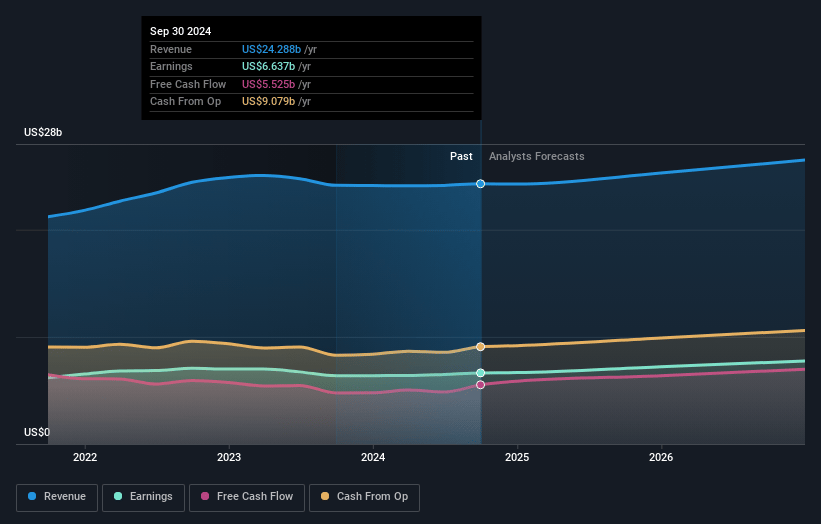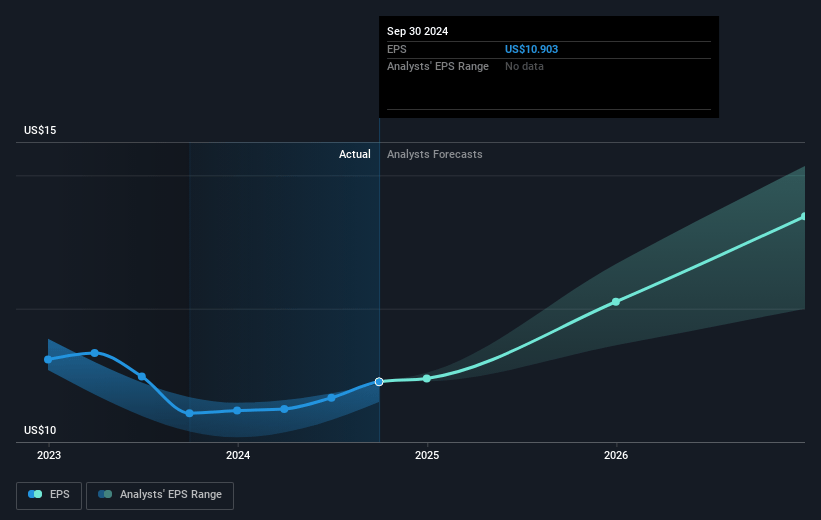Narratives are currently in beta
Key Takeaways
- Investments in safety and operational excellence improve efficiency and reduce costs, enhancing net margins and earnings.
- Strong pricing and productivity gains, coupled with capital investments, support long-term growth and operational efficiency, boosting profitability.
- Union Pacific faces margin and revenue challenges due to low-demand coal, intermodal mix pressure, industrial declines, wage inflation, and flat fuel surcharges.
Catalysts
About Union Pacific- Through its subsidiary, Union Pacific Railroad Company, operates in the railroad business in the United States.
- Union Pacific is investing in safety, service, and operational excellence, which is expected to improve efficiency and reduce costs, positively impacting net margins and earnings.
- The significant increase in International Intermodal volume indicates potential future revenue growth through market share gains and improved service offerings, impacting revenue positively.
- Continued productivity improvements, such as workforce and locomotive productivity, are expected to drive cost efficiencies, benefiting net margins and profitability.
- Strong pricing gains, despite mix pressures, are expected to exceed inflationary cost increases, potentially enhancing net margins and earnings.
- The company's capital investment strategy, including technology and infrastructure improvements, is likely to support long-term growth and operational efficiency, thereby enhancing earnings.
Union Pacific Future Earnings and Revenue Growth
Assumptions
How have these above catalysts been quantified?- Analysts are assuming Union Pacific's revenue will grow by 4.2% annually over the next 3 years.
- Analysts assume that profit margins will increase from 27.3% today to 30.0% in 3 years time.
- Analysts expect earnings to reach $8.2 billion (and earnings per share of $14.54) by about January 2028, up from $6.6 billion today.
- In order for the above numbers to justify the analysts price target, the company would need to trade at a PE ratio of 21.7x on those 2028 earnings, up from 21.1x today. This future PE is lower than the current PE for the US Transportation industry at 28.9x.
- Analysts expect the number of shares outstanding to decline by 2.22% per year for the next 3 years.
- To value all of this in today's terms, we will use a discount rate of 7.12%, as per the Simply Wall St company report.
Union Pacific Future Earnings Per Share Growth
Risks
What could happen that would invalidate this narrative?- Coal demand challenges due to high inventory levels and low natural gas prices could lead to reduced revenue in Union Pacific's Bulk segment.
- The mix pressure from increased low-margin International Intermodal volumes affects overall profitability, putting downward pressure on net margins.
- Continued decreases in Industrial segment volumes and revenue, which include high-margin shipments, may impact earnings growth negatively.
- Wage inflation and higher incentive compensation costs are contributing to increases in compensation expenses, which could reduce net margins and impact profitability.
- The impact of fuel surcharge revenues being flat due to lower fuel prices, alongside potential further reductions, may hinder freight revenue growth.
Valuation
How have all the factors above been brought together to estimate a fair value?- The analysts have a consensus price target of $257.4 for Union Pacific based on their expectations of its future earnings growth, profit margins and other risk factors. However, there is a degree of disagreement amongst analysts, with the most bullish reporting a price target of $285.0, and the most bearish reporting a price target of just $218.0.
- In order for you to agree with the analyst's consensus, you'd need to believe that by 2028, revenues will be $27.5 billion, earnings will come to $8.2 billion, and it would be trading on a PE ratio of 21.7x, assuming you use a discount rate of 7.1%.
- Given the current share price of $230.54, the analyst's price target of $257.4 is 10.4% higher.
- We always encourage you to reach your own conclusions though. So sense check these analyst numbers against your own assumptions and expectations based on your understanding of the business and what you believe is probable.
How well do narratives help inform your perspective?
Disclaimer
Warren A.I. is a tool utilizing a Large Language Model (LLM) that ingests data on consensus price targets, forecasted revenue and earnings figures, as well as the transcripts of earnings calls to produce qualitative analysis. The narratives produced by Warren A.I. are general in nature and are based solely on analyst data and publicly-available material published by the respective companies. These scenarios are not indicative of the company's future performance and are exploratory in nature. Simply Wall St has no position in the company(s) mentioned. The price targets and estimates used are consensus data, and do not constitute a recommendation to buy or sell any stock, and they do not take account of your objectives, or your financial situation. Note that Warren A.I.'s analysis may not factor in the latest price-sensitive company announcements or qualitative material.
Read more narratives
There are no other narratives for this company.
View all narratives



